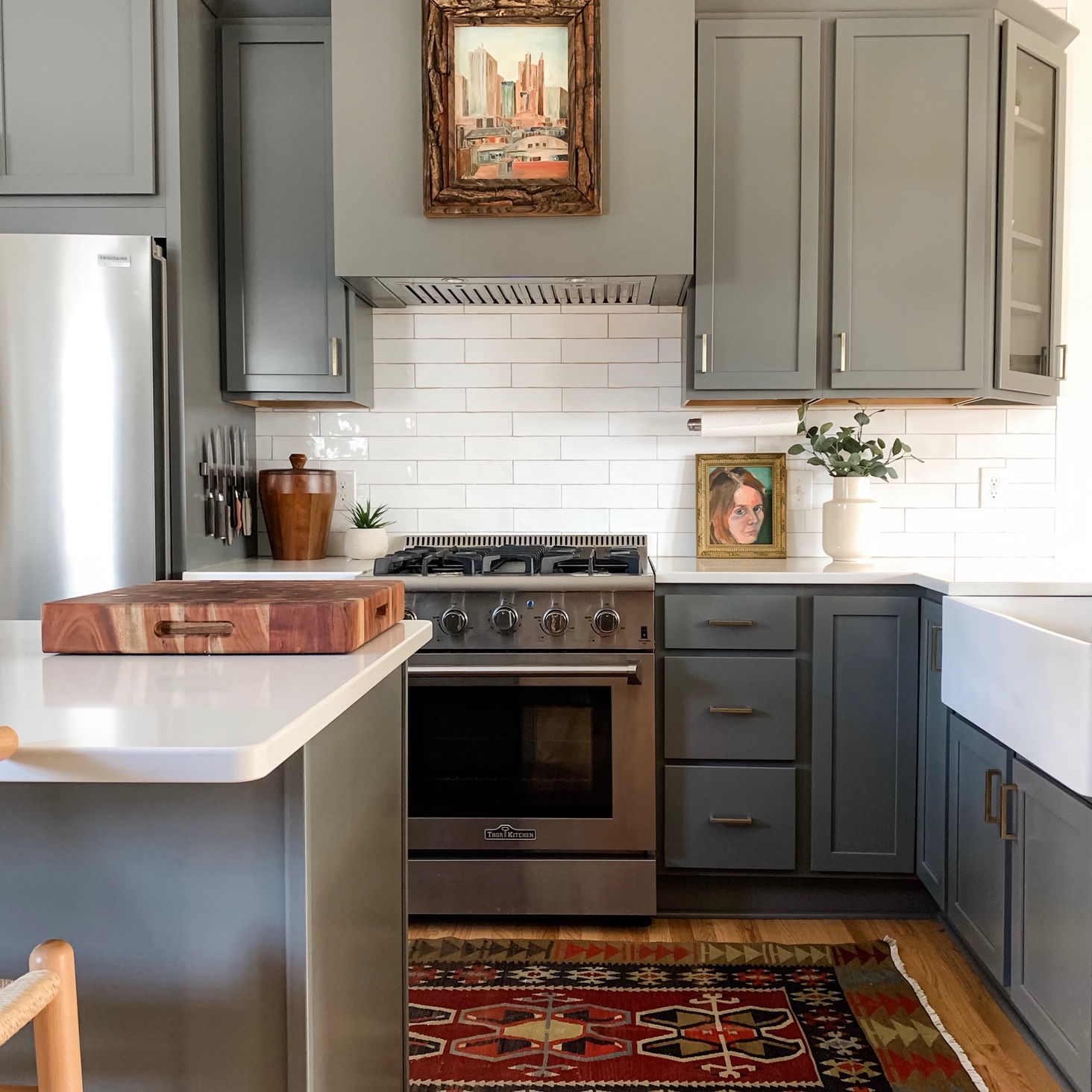 Loading... Please wait...
Loading... Please wait...Merillat - MERILLAT CLASSIC® COLLECTION KITCHEN
THE RIGHT RUG FOR YOUR MERILLAT CLASSIC® COLLECTION KITCHEN
Posted by Merillat Marketing on Mar 25th 2020

One of the most common questions I receive about vintage rugs is whether or not I recommend placing them in the kitchen. My answer is a resounding YES! Understandably, there is concern about food and beverage spills ruining your investment. If you check out the following guidelines, you won’t regret adding a vintage piece that will undoubtedly add warmth and character to what can otherwise be a cold flooring.

THE RIGHT SIZE
Finding the right size AND colors in a vintage rug can be a daunting task. Especially in the kitchen when you have less flexible spaces. Consider using a mini rug in front of the sink and/or stove to provide a cushioning under foot for spaces you tend to stand for longer periods of time. My favorite look in a kitchen however, is a long skinny runner which tends to draw the eye forward and give the illusion of a larger space. Just remember to try and keep the edges of your rug at least 3 inches away from the cabinet toe-tick or the wall, depending on your space.

THE PERFECT COLORS
This topic is widely up for interpretation and really up to your personal preference. In our personal kitchen, we have Merillat Classic® Collection cabinets which are a blue-gray color paint called Graphite. When choosing a rug, I like to incorporate that color in the piece somewhere. Whether it’s the main field color or an accent in the rug, it creates a more cohesive look in the space when you can tie the cabinet color into the rug. Or, if you prefer to keep it simple and more safe, choose a neutral rug that doesn’t compete with the existing colors in your room. Either way, I always advise customers to choose a rug that sparks joy for you (I know, this term is so 2019, but it’s true!) When you find a rug that really makes you swoon, you jump on it! There are always ways to tie in coordinating colors with decor products to make it work for your home.
THE RIGHT MATERIALS FOR FUNCTIONALITY
There are a few differences in the materials in vintage rugs and the way that particular material affects texture. Two of the most common types of rugs we carry at Six Vintage Rugs is wool on wool or wool on cotton . The wool on wool piece means just that - a wool pile (top part of rug), on a wool foundation (bottom or backside of rug). Typically, the wool on wool rugs are soft and floppy. This creates a very beautiful texture but isn’t my first choice for high traffic spaces like the kitchen. I prefer these pieces be placed in family living spaces under a comfy couch and coffee table.
Wool on cotton (foundation) is my go-to for the kitchen. This cotton foundation creates a very tight and sturdy base and doesn’t bunch as easily. Most of these pieces also have a shaved pile which allows for a low profile that will last you for decades in high traffic spaces.
Side note: this is not to say you can’t place wool on wool rugs in the kitchen! Just be aware that you will need a thicker, heavier duty rug pad and remember that these pieces are more delicate and might show high traffic wear quicker than wool on cotton.

RUG CLEANING AND MAINTENANCE
This is the largest concern when it comes to vintage rugs in the kitchen. As long as spills are tended to after they happen and don’t sit for ages, they are really easy to clean. Here are the steps I take to spot clean my vintage rugs:
- Place a medium sized bowl under the affected area to catch the liquid solution.
- Mix 4 parts warm water with 1-part white vinegar and a few drops of clear dish soap or clear laundry detergent
- Pour solution onto spot slowly and let it absorb all the way through the rug and into the bowl.
- Then pour clear water to rinse solution.
- Remove bowl and replace with a folded towel underneath rug.
- Using a white towel free of dyes, blot (don’t rub) the affected area and keep rotating the white towel to avoid redepositing the stain.
- Lay rug in direct sunlight until dry or if that is not an option, you can use a blow dryer on cool to hand dry, making sure you blow air on each side of the rug.
You can easily keep up with the maintenance of your vintage piece by vacuuming the top side of the rug weekly and the underside of the rug monthly to avoid dirt settling. One of the best things about vintage rugs is they are typically colorful and ornate in design, so they are fantastic at hiding any dirt or staining. If you follow these guidelines, you will undoubtedly have an heirloom piece of decor that will warm the kitchen in your home for decades to come.
